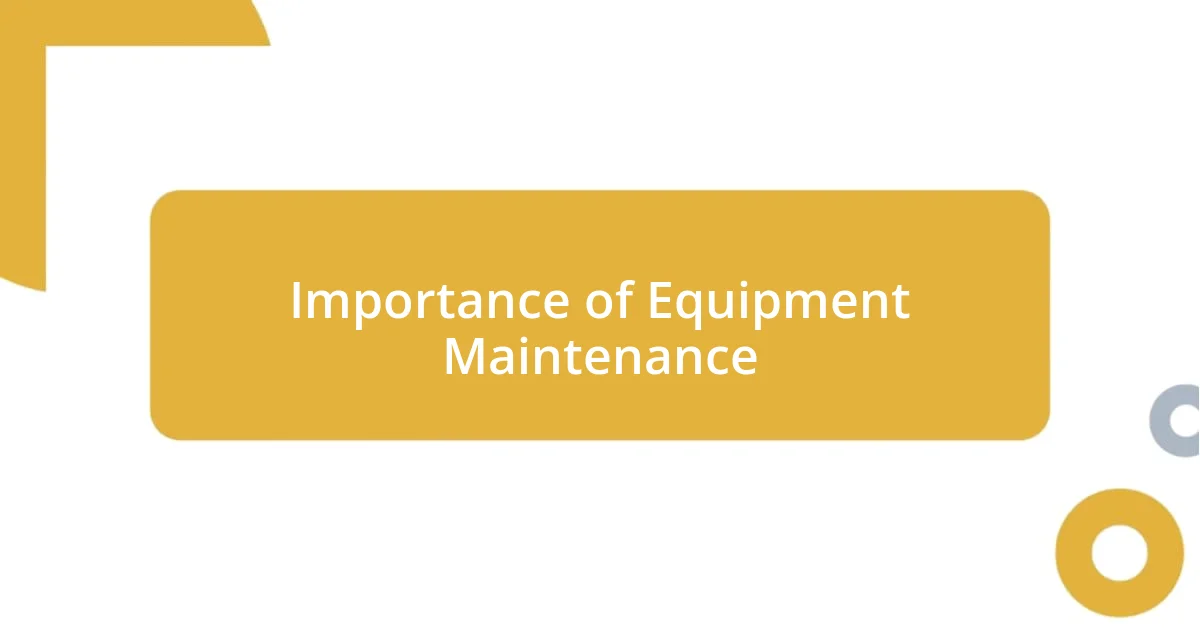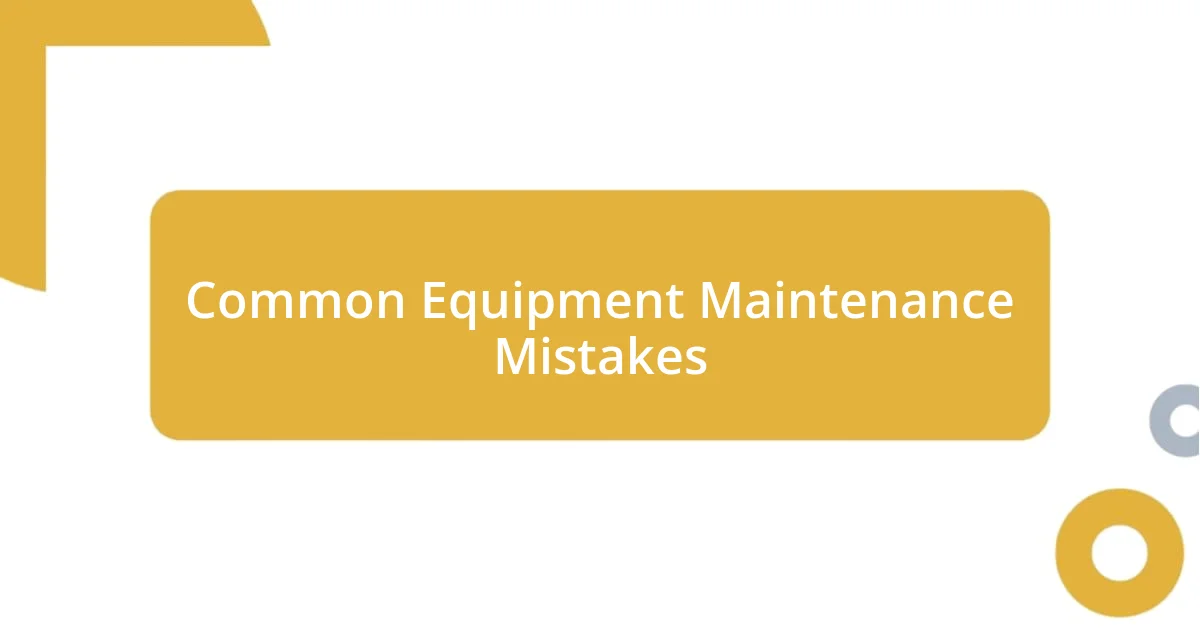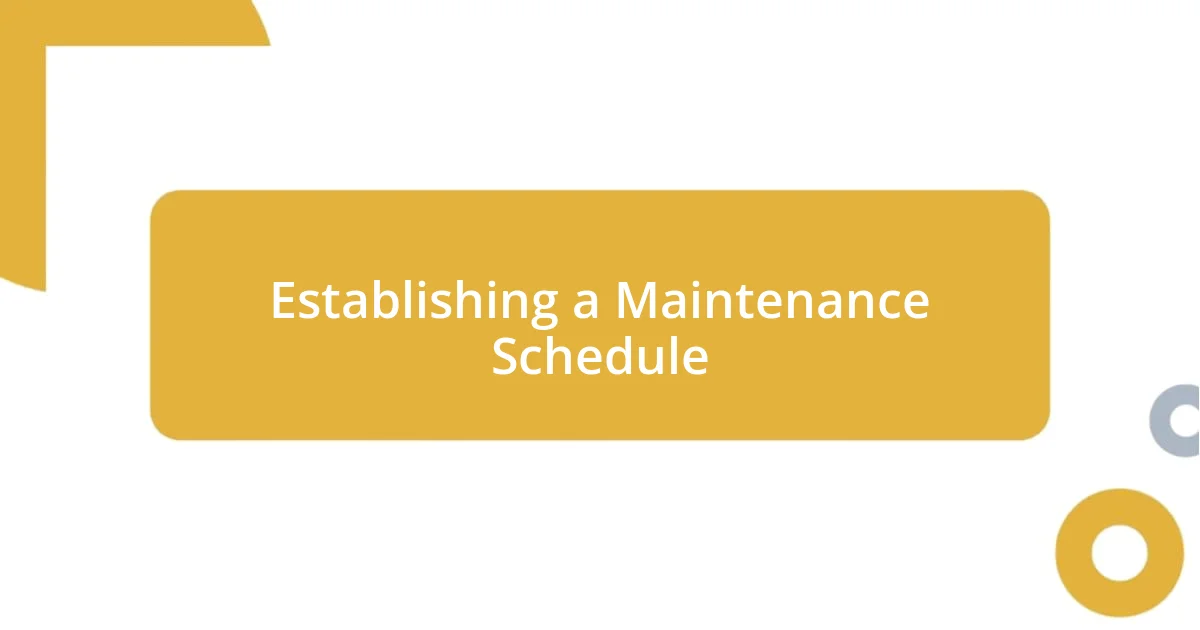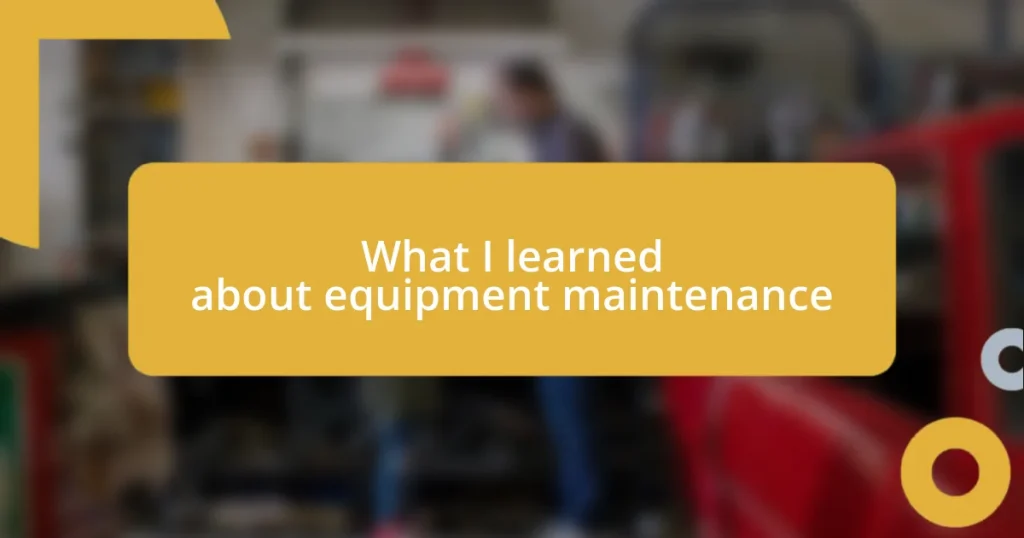Key takeaways:
- Regular equipment maintenance maximizes lifespan, prevents breakdowns, saves costs, and enhances workplace safety.
- Establishing a structured maintenance schedule fosters accountability, improves efficiency, and encourages teamwork.
- Training staff in maintenance protocols and regularly evaluating outcomes strengthens skills, promotes proactive care, and leads to continuous improvement.

Importance of Equipment Maintenance
Equipment maintenance is crucial for maximizing the lifespan of machinery. I remember when I neglected routine checks on a piece of equipment, and it ultimately failed during a critical project. The stress in that moment was palpable, highlighting just how vital it is to keep things running smoothly.
Regular maintenance not only prevents unexpected breakdowns but also saves money in the long run. Have you ever considered how much downtime costs your operations? I once calculated the expenses incurred from a single day of equipment failure, and it was eye-opening. That experience taught me that investing time in maintenance isn’t just about upkeep; it’s about safeguarding financial stability.
Moreover, proper equipment maintenance fosters a safer work environment. I vividly recall a close call when an unmaintained machine malfunctioned, nearly resulting in injury. It’s a sobering thought — could a little preventive care have changed that outcome? Prioritizing maintenance means not only caring for your tools but also for the people who rely on them daily.

Common Equipment Maintenance Mistakes
Ignoring equipment manuals is a common pitfall in maintenance routines. I learned this the hard way when I bypassed some critical instructions on maintenance intervals for a vital piece of machinery. The result? A costly repair that could have been easily avoided. Equipment manuals offer tailored guidelines for extending lifespan and ensuring peak performance, so referring to them is essential.
Here are some common equipment maintenance mistakes to watch out for:
- Skipping routine inspections due to time constraints.
- Overlooking filter changes, leading to reduced efficiency.
- Misidentifying the signs of wear, which can escalate issues.
- Neglecting to document maintenance actions, complicating future repairs.
- Failing to train staff on proper maintenance protocols, resulting in inconsistent care.
It’s so easy to fall into these traps, especially when you’re caught up in daily tasks. But trust me, taking the time to stay informed and proactive makes all the difference.

Establishing a Maintenance Schedule
Establishing a maintenance schedule is like drawing a roadmap for your equipment care journey. I’ve found that setting specific times for inspections or service can help prevent costly surprises down the line. There was a time when I had a lackadaisical approach to maintenance, which led to a sudden equipment failure that derailed an entire project. Trust me, having a structured schedule has been a game changer.
Creating a calendar for maintenance tasks not only keeps machinery in top shape, but it also sets clear expectations for everyone involved. I’ve experienced situations where team members were unsure of their responsibilities, leading to oversight in care. When we implemented a detailed maintenance schedule, everyone became accountable. It cultivated a sense of teamwork that I didn’t expect, and our efficiency soared.
Consistency is key in this process. Just like working out or adhering to a diet, regular check-ups lead to long-term benefits. I once missed a scheduled inspection because I thought the equipment was performing fine. It turned out to have hidden issues that could have been caught early. Now, I make it a point to uphold my maintenance schedule religiously — it’s an investment in both time and trust.
| Maintenance Task | Frequency |
|---|---|
| Routine Inspections | Monthly |
| Filter Changes | Quarterly |
| Lubrication of Moving Parts | Bi-Weekly |
| Comprehensive Equipment Checks | Annually |

Tools for Effective Maintenance Tracking
When it comes to effective maintenance tracking, I’ve discovered that leveraging technology makes a world of difference. For instance, I started using maintenance management software, and it’s like having a personal assistant for my equipment. The alerts alone have spared me from several close calls, reminding me of tasks before they escalate into bigger problems. Have you ever been caught off guard by an unexpected breakdown? I truly regret those days when I relied solely on memory; the software not only documents everything but also gives insights into patterns.
Another useful tool I’ve found is a simple spreadsheet template. It may seem old-school, but the visual layout helps me monitor tasks in real-time. Each time I tick off a completed maintenance task, I feel a rush of satisfaction and clarity, as if I’m taking control of my operational life. Plus, sharing this document with my team fosters collaboration. Who doesn’t appreciate a little teamwork when tackling maintenance?
Lastly, mobile apps deserve a shout-out in this conversation. They grant you the flexibility to track maintenance on the go. I remember a time I was away from the site and got a text about an equipment issue. Instead of panicking, I quickly accessed the app and was able to guide my team on needed actions. Isn’t it comforting to know that help is just a tap away? Embracing these tools has not only streamlined my maintenance process but also eased my overall stress, allowing me to focus on what truly matters.

Best Practices for Maintenance Procedures
One of the best practices I’ve learned for maintenance procedures is documenting everything meticulously. I still remember a period when I neglected keeping detailed logs of repairs and adjustments. It became a frustrating guessing game later on — was that noise normal? Did we change that filter recently? Now, I make it a habit to jot down key observations right after each maintenance check. This not only serves as a reference for future inspections, but it also helps me note any recurring issues that might need further attention.
Engaging the team in the maintenance process is another vital strategy. I once initiated a “maintenance day” where everyone, regardless of their usual role, participated in hands-on care for our equipment. The result? Not only did we tackle some much-needed tasks, but it also fostered a newfound appreciation for the machines we work with. How often do we take the time to understand the tools that drive our work? This collective engagement not only enhances accountability but strengthens our workplace bond, leading to more proactive care.
Finally, never underestimate the value of continuous learning in maintenance practices. I’ve attended workshops and webinars throughout the years that opened my eyes to new techniques and technologies. When I learned about predictive maintenance — using data to anticipate failures before they occur — it revolutionized my approach. How much more effective could our operations be with a proactive mindset? Adapting this knowledge has not just improved equipment longevity but also lifted my team’s morale, knowing we were ahead of potential problems instead of constantly playing catch-up.

Training Staff on Maintenance Protocols
Training staff on maintenance protocols is essential for fostering a culture of proactive care. I remember the first time I held a training session — the nervousness was palpable, but the engagement that followed blew me away. We worked through real-life scenarios where each team member expressed their concerns and insights. Isn’t it fascinating how a little shared knowledge can transform fear of the unknown into confidence?
I’ve found that incorporating hands-on practice during training sessions is incredibly effective. Once, I set up a mock equipment failure scenario, and watching my team troubleshoot in real-time was exhilarating. There’s something incredibly empowering about learning through doing, isn’t there? Not only did we resolve the issue collaboratively, but I also witnessed the birth of problem-solving skills that they took pride in — a true testament to the importance of practical training.
Regularly revisiting and updating our maintenance protocols is another key aspect that’s made a remarkable difference. I prioritize monthly meetings where we discuss what we’ve learned, share experiences, and suggest improvements. It’s a great check-in opportunity, especially when someone shares a success story about preventing a breakdown using a protocol we discussed. Doesn’t it feel rewarding to see progress and collaboration in action? Each discussion strengthens our commitment and makes me excited to see how our maintenance capabilities evolve.

Evaluating Equipment Maintenance Outcomes
Evaluating the outcomes of equipment maintenance is essential to understanding our overall effectiveness. Whenever I review our maintenance history, I look beyond just the numbers and reflect on moments that stand out. For instance, I remember a time when we implemented a new lubrication schedule, which significantly reduced equipment downtime. That’s not just a statistic; it’s a reminder of the value of making informed adjustments.
I often find myself asking, “How do we truly measure success in maintenance?” It’s certainly not just about extending equipment lifespan, although that is a huge factor. I get a real sense of achievement when I see my team confidently handling equipment challenges that used to stump us. Those moments of growth tell me we’re on the right track and underline the importance of effective training and evaluation processes.
Moreover, creating a feedback loop is something I consider crucial. After every significant maintenance project, I initiate discussions where my team can share their thoughts. One time, a technician pointed out a flaw in our approach, and it led to a brilliant strategy adjustment that improved our workflow. This collaborative evaluation not only elevates our practices but also strengthens our team spirit. Isn’t it fascinating how shared insights can lead to profound improvements?















